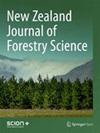Optimisation of ultrasound assisted extraction of antiacetylcholinesterase and antioxidant compounds from manuka (Leptospermum scoparium) for use as a phytomedicine against Alzheimer’s disease
IF 1.1
4区 农林科学
Q2 FORESTRY
引用次数: 3
Abstract
Background: Alzheimer’s disease is a progressive mental deterioration related to ageing and senility. Approved drugs that inhibit acetylcholinesterase (AChE) enzyme activity in the human brain are one of the ways to control the natural progression of this disease. The present study reports on the optimisation of ultrasound-assisted extraction of antiacetylcholinesterase and antioxidant compounds from manuka leaves using response surface methodology. Methods: A Box-Behnken design was used to investigate the effect of extraction temperature (40–60°C), time (1–20 min), and ethanol concentration (30–70%) on AChE inhibition, antioxidant activity, and extraction yield. Results: The values of AChE, radical scavenging activity (RSA) and yield predicted by the models generated were similar to the experimental values. Extraction time, ethanol concentration and temperature were significant in all the responses. Optimum extraction conditions for maximum AChE inhibition (74%), RSA (79%) and yield (50%) were successfully validated experimentally and the IC50 of the optimised extracts were reduced to 28.5 (from 66.0) and 2.37 (from 32.4) ?g/ mL for AChE and antioxidant activity, respectively. The optimisation enabled an increase in the extraction yield from 21% to 49%. Conclusions: In view of the significant bioactive properties determined, with possible beneficial effects on memory deficit, we would encourage the use of the manuka leaf extract for the development of new phytopharmaceuticals to improve brain function and control dementias such as Alzheimer’s disease. One other application could be as a beverage for the preparation of tea infusions.超声辅助提取麦卢卡草抗乙酰胆碱酯酶和抗氧化化合物用于抗阿尔茨海默病植物药的优化
背景:阿尔茨海默病是一种与衰老有关的进行性精神退化。经批准的抑制人脑乙酰胆碱酯酶(AChE)活性的药物是控制这种疾病自然进展的方法之一。本研究采用响应面法对麦卢卡叶中抗乙酰胆碱酯酶和抗氧化化合物的超声辅助提取工艺进行了优化。方法:采用Box-Behnken设计,考察提取温度(40 ~ 60℃)、时间(1 ~ 20 min)、乙醇浓度(30 ~ 70%)对乙酰胆碱酯酶抑制、抗氧化活性和提取率的影响。结果:所建立的模型预测的AChE、自由基清除活性(RSA)和产率与实验值相近。提取时间、乙醇浓度和温度对这些反应均有显著影响。实验验证了最佳提取条件对AChE的最大抑制作用(74%)、RSA(79%)和产率(50%),优化后的提取物对AChE和抗氧化活性的IC50分别降至28.5(66.0)和2.37 (32.4)?g/ mL。优化后的萃取率从21%提高到49%。结论:鉴于麦卢卡叶提取物具有显著的生物活性,可能对记忆缺陷有有益的影响,我们将鼓励利用麦卢卡叶提取物开发新的植物药,以改善大脑功能和控制阿尔茨海默病等痴呆症。另一种应用可以作为茶泡剂制备的饮料。
本文章由计算机程序翻译,如有差异,请以英文原文为准。
求助全文
约1分钟内获得全文
求助全文
来源期刊

New Zealand Journal of Forestry Science
FORESTRY-
CiteScore
2.20
自引率
13.30%
发文量
20
审稿时长
39 weeks
期刊介绍:
The New Zealand Journal of Forestry Science is an international journal covering the breadth of forestry science. Planted forests are a particular focus but manuscripts on a wide range of forestry topics will also be considered. The journal''s scope covers forestry species, which are those capable of reaching at least five metres in height at maturity in the place they are located, but not grown or managed primarily for fruit or nut production.
 求助内容:
求助内容: 应助结果提醒方式:
应助结果提醒方式:


